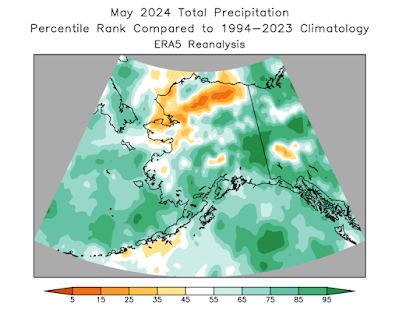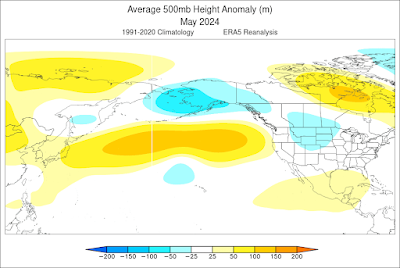As alluded to in Mike's post yesterday, an upper level ridge has brought very warm conditions to much of Alaska, and yesterday was downright hot in parts of the interior and north, with temperatures reaching well into the 80s. The Whitestone Farms co-op site near Delta Junction reported 90°F, and that should be quite reliable, unlike the RAWS thermometers that always read high in the strong summer sunshine.
Elsewhere, Eielson AFB reached 87°F, North Pole saw 86°F, and Eagle reported 87°F. Fairbanks airport, in contrast, only reached 81°F because of dense smoke in the morning: the McDonald and Clear fires are burning to the south of the Tanana River.
The enhanced satellite image below, posted by NWS Fairbanks, shows the location of active fires with the bright red colors. Note the smaller but still substantial fires to the northwest of Fairbanks too.
Here's a view of yesterday's high temperatures. Even on the North Slope temperatures jumped up into the 80s, including 85°F (maybe too high) at the Umiat RAWS and 80°F at Nuiqsut. Up in the Brooks Range, Anaktuvuk Pass reached 78°F, which is pretty remarkable.
Statewide fire acreage has reached 148,000 acres according to the AICC. This is a significant increase from a week ago, but that's to be expected at the time of year, and the running total remains somewhat below normal.
The relatively modest increase in fire acreage despite very warm conditions recently is probably related to the fact that lightning activity has not been especially problematic. Sunday and Monday had about 11000 lightning strikes between them statewide, which is notable, but other than that lightning activity has been fairly subdued. In fact, the total strike count in June is running about 25% below normal, based on a short history since 2012.
But the wet spring probably also has a lot to do with the (so far) modest fire season: ground moisture coming into the season was certainly higher than normal in many places.
https://ak-wx.blogspot.com/2024/06/may-climate-data.html
https://ak-wx.blogspot.com/2024/05/april-climate-data.html





























